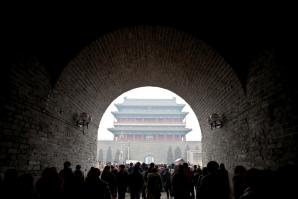As demand increases for U.S. products in China, government leaders in the Capital Region and across the country are making a push to foster connections between small, local businesses and the world’s fastest growing consumer market.
Since Chinese Communist Party chief Xi Jinping toured California last year, the state has reenergized efforts to accelerate trade ties with the Eastern nation. Gov. Jerry Brown announced plans to reopen the state’s trade offices in China, which closed in 2003 under budget constraints. The Governor’s Economic Development Office, or GoBiz, is working with California and Chinese companies on assembling a Brown-led trade mission to Beijing, Shanghai and Guangzhou this month.
Meanwhile, in response to President Obama’s 2010 call to double American exports in five years, other federal programs are forging stronger links with overseas markets. The State Trade & Export Promotion program (STEP) uses federal grants to help local businesses enter trade shows and set up marketing events in other countries.
Additionally, the Export-Import Bank of the United States, the federal government’s official export credit agency, has increased financing for small businesses by 40 percent since 2009. The Ex-Im Bank can provide export financing when private banks won’t.
In the local private sector, membership organizations such as the California Asian Pacific Chamber of Commerce are also organizing China trade missions of their own to help identify buyers and investors interested in California companies.
The state believes it can increase domestic jobs by ramping up sales in China and attracting Chinese investment in California, says Paul V. Oliva, the deputy director of international affairs and business development for GoBiz.
China is California’s third-largest export market behind Mexico and Canada. Brown’s 10-day trade mission will bring more than 50 California businesses to China in three major sectors — food and agricultural, sustainable living and “California lifestyle” goods ranging from eco-friendly innovations to motion picture technology and beauty products — in addition to real estate developers, law firms and banks to facilitate dealmaking.
Those sectors represent the uniquely Californian products that the new Chinese bourgeoisie desire — smart buildings and grids and zero-emission vehicles to generate clean air, and California wines, fresh fruits and vegetables.
To help small businesses that lack the resources to promote their exports, state officials are also working with their Chinese counterparts to reopen California-China Trade and Investment Offices in Beijing and Shanghai.
GoBiz hopes to launch its 4-member Shanghai office this spring using both public and private funding. Once in place, the office will partner with an array of federal trade offices and regional economic development programs to extend California’s reach into the country, Oliva says.
There is also a growing recognition that individual California cities need to form relationships with Chinese importers. Former Sacramento Councilman Rob Fong is spearheading an effort to create a trade partnership between Sacramento and the inland industrial hub of Chongqing, China. The city of San Francisco has offices in Shanghai and Beijing. The Bay Area Council has offices in Beijing and Hangzhou, and Los Angeles has an office in Chongqing. Together they can help locate specific buyers for a range of California products.
“It’s a very, very large state, so there may be hundreds, even thousands that would benefit” from our services, Oliva says. “We’re hoping to help at least 60 companies with some form of sales or investment this year.”
Whereas GoBiz is configured to work with private enterprises of all sizes, STEP has received more than $2 million of federal funding to bolster its services for small businesses that are trying to get a sense of their market potential in China and elsewhere.
Jeff Williamson, director of California STEP, advises interested companies to conduct an export readiness assessment to see what assets they can apply to Chinese buyers. “One of the most important things for companies to build their business in China or elsewhere is to understand how their product can be used in that market,” Williamson says. “It’s very difficult to do that without someone going to the market and conducting their own firsthand market research.”
That’s where STEP comes in. Last year, the program helped take nine California companies to the annual China Medical Equipment trade fair, which this year will coincide with Brown’s trade mission. By forging connections to the U.S. Department of Commerce, STEP helps U.S. companies navigate the Chinese bureaucracy, explains Williams. For example, in China, medical products have to be registered as medical instruments, and the process can take up to two years.
STEP can also help defray the cost of a trade booth or marketing materials. It typically costs small companies an average of $3,000 to get a sample of their products to China, according to Brooks D. Ohlson, director of the Sacramento Regional Center for International Trade Development, which both shares an office with the U.S. Commercial Service and works alongside STEP. But companies that qualify can get funding from STEP as well as training and consulting advice.
“We get them into a market, then we follow up with them when they come back and help them determine how to fill orders and pay,” Ohlson said. “We’re there to hold their hand.”
Williamson advises companies to develop networks with major chambers of commerce, the Small Business Administration, the departments of commerce in different countries and others. While STEP has particularly strong knowledge in information technology, food and agriculture, industrial and scientific machinery and lifestyle products, sources of information for unique products and services can vary greatly. “There’s not a single pathway. It’s better to reach out to and build networks among multiple organizations.”
That proved to be a winning strategy for PASCO Scientific, a Roseville-based purveyor of science education software and lab equipment that has been exporting to mainland China for more than a decade. “One of the things we’ve learned is that you can never learn enough,” says Mike Bridge, a company spokesman. PASCO has been exporting for 35 years and maintains friendly relationships with U.S. commercial attaches abroad, who have their finger on the pulse of a country’s political and funding climate.
The company also takes advantage of Ex-Im Bank for help on its export financing needs. “Our business can be very seasonal, and we have major projects that demand cash,” Bridge says. The company’s working capital credit line doesn’t extend to its business outside of the U.S., so it turns to the federal export credit agency. “Ex-Im Bank allows us to handle those working capital demands, because otherwise, doing business abroad would require much deeper pockets,” he says.
Ex-Im Bank recently financed Northern California exports of rice cakes and wine to China, says Jim Lucchesi, senior export finance manager of the bank’s San Francisco field office.
PASCO representatives say mingling with other companies at international industry events is key to finding potential trade partners, but building lasting relationships requires deeper vetting. “We typically find partners by networking with other companies in the same industry that are not our direct competitors and finding who their partners are,” says Kevin Mather, PASCO’s vice president of international business. “You have to balance finding that compatible partner with making a decision quickly enough to take advantage of opportunities … It’s a lot like a marriage.”
Local organizations offer inroads to a number of trade shows in China. The California Asian Pacific Chamber of Commerce organized its first self-funded trade mission to China last year, bringing 18 companies to Kunshan, a city on the outskirts of Shanghai. The trip produced a “fantastic response,” says Gordon Hinkel, the chamber’s public policy director. Prune producers saw an immediate uptick in exports to China.
As the chamber plans a bigger China trade mission for May, it’s also working to create a permanent platform in China for businesses looking to showcase their goods, products and services, says Hinkel.
“What we notice is that small and medium enterprises are looking to get a foothold in China and don’t know where to start,” he says. “To give them a boost through an exhibition hall or pavilion would allow them to better test the market for their products, skills and services. I think it’s exciting.”
Recommended For You

World Travel
Can Sacramento cash in on an influx of Chinese tourism dollars?
Two hundred million Chinese tourists will pack their bags and depart their homeland in 2020, bound for destinations across the globe. It’s not a mass exodus; they’re not fleeing their government. They’re tourists, and, according to CNN, they might be the greatest phenomenon to hit the global travel industry since the invention of commercial flight.

Enter At Your Own Risk
So you think your business is ready to dive into China?
Terry Green was sitting at home a few years ago when his cell phone rang.
Would his company be interested in doing some projects in China?



